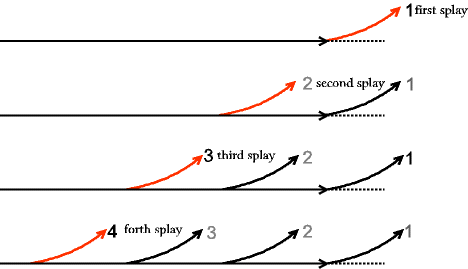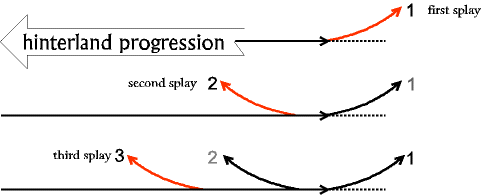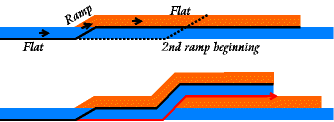It is possible to have a single, isolated thrust fault, but more commonly they come in sets that may include dozens of individual faults. Conceptually, thrust faults are straight forward, but they can quickly become very complex; entire books are written on this geology. For example, these examples we will examine in more detail laters: Example 1; Example 2. If you are unfamiliar with thrust fault patterns they can look chaotic, confusing and meaningless. But you can learn to see the obvious patterns, and understand what they mean. Thrust faults do have pattern and meaning. . Processes of Thrust Fault Development . Thrust faults develop when one block of earth, the hinterland, collides with and compresses another block, the foreland. The force of the hinterland and its movement creates horizontal stresses in the foreland rocks causing them to thrust fault and move. Similarly, stresses in the hinterland also lead to thrust faulting.  The drawing to the right illustrates a hinterland moving from left to right over the edgte of a foreland; a modern day example is Asia sliding up over northern India to create the Himalayan mountains. As the hinterland moves, its force and movement sets up stresses in the underlying foreland rocks causing them to shear from left to right. Or, as the hinterland pushes inland, deformation of the foreland rocks also moves inland, for example, on the drawing from ramp fault number 1, to 2, to 3, etc.
The drawing to the right illustrates a hinterland moving from left to right over the edgte of a foreland; a modern day example is Asia sliding up over northern India to create the Himalayan mountains. As the hinterland moves, its force and movement sets up stresses in the underlying foreland rocks causing them to shear from left to right. Or, as the hinterland pushes inland, deformation of the foreland rocks also moves inland, for example, on the drawing from ramp fault number 1, to 2, to 3, etc.Thrust fault deformation comes in two varieties, "decollement and imbricated splays", and "ramp and flat". These are not distinct from each other, but are end members in a spectrum. Most of the complexity we see in thrust-belt systems are generally combinations of these two faulting variations. In the first set of drawings below the rocks are not shown, just lines for the faults. Arrows show the direction of movement. There is no scale implied in the drawings, but we are dealing with structures involving thousands of feel of strata, measured in miles horizontally. Decollement and Imbricate Splays: horizontal fault-plane (the decollement) with upward curving splay faults. The splays develop in sequence, normally beginning closest to the source of stress, and migrating inward toward the foreland (foreland progression). Each drawing below represents the next stage of development. The splays are numbered in the drawing in order of their appearance.  Alternatively, there are occasions where the splays develop behind, and after, the frontal splay. That is, they develop back toward the hinterland rather than toward the foreland. Still, these splay upward in the direction of the foreland.  Finally, there are occasions where the splays not only develop behind, and after, the frontal splay, but the splays also splay back toward the hinterland; a hinterland progression.  These series of splay thrusts are said to be "imbricate"; stacked together something like shingles laid against a wall. This kind of thrust faulting is very common. See if you can find samples in Example 1 and Example 2. Ramp and Flat: horizontal fault (glide) plane (the flat) that ramps up through the rocks until it reaches another glide horizon, and then begins to move horizontally (another flat) on the upper glide surface of the underlying rock. It is not unusual for the ramp to cut through thousands of feet of rock-thickness, and for the thrust sheet to move tens of miles along the upper flat. Sometimes at the end of the flat the moving rocks get stuck and curl over to form an overturned anticline. In some cases the rocks do not move long distances along the flat, but just curl over and stop moving, forming a "ramp and overturned anticline". It is like at the beginning of the second flat the thrust sheet locked up and could move no farther.  It is not unusual for the overturned anticline to be associated with a major thrust sheet, such as with the Blue Ridge anticlinorium, or the overturned anticline just east of the Allegheny Front, seen, for example, at Germany Valley. In other places, however, after the overturned anticline forms the rocks just keep deforming producing an even more complex structure (Giles and Eagle Rock examples below). This simple introduction alone will help you recognize fault structures in thrust belt systems such as the Appalachians. If you want to understand a little about why the rocks behave this way, or want to see some examples of just how complex all this can become, read on. GENERATION OF DECOLLEMENT AND IMBRICATE THRUST FAULTING  Imagine a hinterland beginning to shove into a foreland. Under the horizontal stresses, the rocks begin to fault, close to the point of collision where the stresses forces are greatest, and then migrate inland toward the foreland interior (see above cross section). We illustrate the generation of a single decollement and ramp with the use of the block diagrams to the right.
Imagine a hinterland beginning to shove into a foreland. Under the horizontal stresses, the rocks begin to fault, close to the point of collision where the stresses forces are greatest, and then migrate inland toward the foreland interior (see above cross section). We illustrate the generation of a single decollement and ramp with the use of the block diagrams to the right.Block 1: Imagine a block of the earth undergoing horizontal stresses and deforming. The large red arrow numbered 1 is the stress. The purple arrow is the actual fault, where the rock has already broken and begun to move. The dashed black line is an incipient fault; the rock in front of the fault is stressed but has not broken yet. But as the stresses migrate inland, faults continue to develop as shown in Block 2 and Block 3. The formation of a fault is akin to tearing a piece of paper. As you pull on it, the paper stretches and deforms before actually failing and tearing. And it fails bit by bit all the way across the page; the sheet does not rip as a whole all at once. And neither does the rock. Block 2: As the rock strength fails, the overlying layer begins to slide over the underlying layer, indicated in the drawing by the top half of the yellow block beginning to move. This is the beginning of a horizontal thrust fault and is called a decollement (basal thrust fault). As the length of the decollement increases, however, the friction along the fault increases, and it takes more and more stress to make it move. Also, the more the fault grows the more rock mass there is to move. Stresses begin to pile up, and look for a way out. Early in an orogeny there is more than enough stress to overcome any resistance, but the stress is going to look for the easiest path to travel through. Obviously down is not the best way; that just goes deeper into the earth where the pressure is greater. And forward is becoming more and more difficult because there is more and more rock to move along the fault plane. What's left is up, so the rocks overcome their cohesive strength and break upward to relieve the stress - ramp 1 in Block 3. Block 3: The ramp, however, is only a short term solution because it can become locked. There is just too much downward directed weight and the upward directed stress cannot overcome it. So, now the easiest way for the stress to be released is forward again toward the foreland. The decollement reactivates and a horizontal fault begins to extend itself forward again . . . until it becomes locked again for the same reasons as above, leading to the formation of Ramp 2. This process of decollement and ramp formation cycles over and over creating ramp after ramp after ramp splaying off a basal thrust fault as it migrates toward the foreland interior. This was shown diagramatically above, and can be seen in this example. RAMP AND FLAT THRUST FAULTING, AND THEN COMPLICATIONS We begin with a quick review of what was discussed above, and then lead into a presentation of some of the complications that exist in thrust belt systems. A second style of thrust fault begins like the decollement and imbricate splay system discussed above, but progresses differently (Block 4). The decollement develops (called the flat), followed by the ramp, but the thrust sheet does not stop moving. Once it has broken through to the top, the ramp (fault) turns flat again, and the thrust sheet just keeps on moving across the top, as in Block 5.  The effect is to double the thickness of the pile of rocks. If you drilled a hole down through the top sheet it would go through the entire thickness, pass through the thrust fault, and then go through the same rocks in the lower sheet. See little "A" shaped drilling rig on Block 5. And, of course, the thrust sheet could get stuck at the top of the ramp to form an anticline (Block 6). As faulting continues, things can begin to get complicated because during the orogeny there is still enormous stress acting on the rocks. But, so far we have assumed that the rocks are uniform in strength, and that the stresses acted smoothly; in short, assumed an ideal world. But, of course, rocks vary greatly in their strength and there is no reason why a thrust sheet should behave uniformly. Stresses are transmitted in very complex ways. Always the forces look for the easiest way out, and those conditions keep changing. Every time a new flat, or ramp, or anticline develops - that is, every time the system becomes more complicated - the more difficult it becomes to predict what will happen. In addition, we have to remember that all these processes are taking place far below ground, under conditions very different from today, and which we cannot know very well. In the end, there are just too many variables. A catalog of all the possibilities would be quite large, and an analysis of why one thing happened instead of another would require a deep analysis. So, instead what we usually do is reverse engineer the system. We look at what is, and try to understand how it came to be. Often the complications we see occur because the thrust systems mix together. Some examples of what is possible are below. Case One - A ramp and basal or floor thrust system that develops a decollement and imbricate ramp system. Imagine a basal thrust where a unit of strata ramps to double the thickness of the strata. But, after the doubling the bottom or basal thrust continues to extend forward forming a decollement. From this extended decollement then a second ramp develops, only this time it ramps through the doubled stratigraphic thickness causing it to quadruple.  Case Two - The Duplex. A duplex is a structural feature with a floor thrust and a roof thrust (i.e. two thrusts running parallel to each other separated by thousands of feet of rock), and in between the floor and roof thrusts are a series of imbricated splay faults. The imbricated splays cause the rock column to shorten and thicken, typically causing the entire pile to overturn. Duplexes usually take two or three separate deformational events to produce, but this is not unusual in a thrust system. One set of forces starts to deform the rocks, but then as orogeny continues different sets of forces can act on the rock.  A duplex typically begins with a decollement (the floor thrust) and imbricate splay system where maybe a dozen splays have formed. Observe the imbricate splay thrusts in red rising off a bottom decollement. The blue thrust is the roof thrust. The green lines represent sedimentary rock layers several thousand feet thick. The drawing was loosely sketched from an example in the Valley and Ridge of southern Virginia. The section line runs NW to SE. Also notice that some of the splay faults connect together. Observe the scale of 8 km; this is a big body of rock. In the next cross section the whole system of ramp thrusts has been itself folded into an overturned anticline; this is the duplex. Observe the orientation of the blue colored thrust to see what the folding has done. Also observe the land surface; thousands of feet of this structure has been eroded, and there were other thrust sheets on top of this one. Rock this deep is hot and plastic while it is folding.  Also observe that where rocks moved up along the ramp thrusts, after the folding they now appear to move downward into the earth. We have not included the strata in the folded version, but you can see in the first drawing it is sliced into sections, and will then be displaced by the folding. We will see an example of that at Eagle Rock. Two Examples of Complex Appalachian Structure in Virginia
IMBRICATED RAMP AND FLAT IN GILES COUNTY VIRGINIAIn the examples above, ramp and flat systems were simple. Here we see some of the possible complications. We are not going to do an analysis of how this cross section developed, but just make observations about the ramps, faults, and folds so that you can see that a great deal of complex structural geology happened here.  Also notice that ramps like 1 and 2 seemed to get hung up and form anticlines, but that 3, and probably 4, arched over the top of ramps 1 and 2 and kept right on going. As a result the blue fault has two ramps on it, number 3 and and the farthest one to the NW. Faults: The blue fault is all the same fault; notice how it became folded as it moved up over the ramp and down into the flat toward the NW. Not only do rock strata fold so do faults. Also notice how faults connect together and then diverge again. It is hard to decide which fault is which, and which moved when. Clearly some of these faults were active for a while, became dormant, and then reactivated at a later time, sometimes only in parts, and maybe for an entirely different reason. Folds: There are lots of anticlinal and synclinal folds in this cross sections, some of them miles in dimensions. But notice that virtually every one of them formed in response to movement along a fault. At the surface these folds would be big, prominent structures, and we might be inclined to think them primary in importance. But, in fact, they are just sympathetic responses to imbricated ramp and flat thrust faulting. EAGLE ROCK In the drawing below, the blue horizontal line is road level, so anything below that is largely conjecture. The faint green line is the top of the exposed outcrop, as seen in the picture, and although there is information up in the trees, it is not that well exposed. To get oriented, the tallest part of the outcrop on the right side of the picture lies between the two far left faults in the drawing.  Bartholomew, et. al., 1974, NE-SW GSA '82 Field Trip Guidebook The structure in an outcrop such as this could be almost impossible to understand by itself. Each of the red lines is a thrust fault. Observe how folded they are and how some of them merge together. Observe how some of the faults are discontinuous, cut by other faults so that they seem to have no origin. And, of course, unlike most thrust faults that ramp upward, these move downward into the ground.To understand an outcrop such as this usually requires some well developed model based on better data that can be applied to the lesser information we have here. The interpretation of this outcrop is based on the duplex structure discussed above. That is, there are a minimum of two stages of deformation, first an imbricated ramp system, which, second, was then folded into an overturned anticline. In this process all the upward directed ramps became folded, with some of them now plunging down into the ground. And it is quite likely that prior to folding the ramp system had some other complex history, such as the multiple ramp and flat system developed in the Giles example (and which, in fact, is not too far away from this outcrop.) Conclusions The structures reviewed here are not atypical of the kinds of structures developed throughout the Appalachian mountains during the Alleghanian orogeny. Oh, each place will have its own unique characteristics, but overall these are the kinds of structures present. So, as you travel through the Valley and Ridge, and as well the Piedmont/Blue Ridge remember, that even though you cannot see all these structures you are in fact imbedded in them. They are all around you, towering thousands of feet above your head, and thousands of feet below the ground, and all formed at a time when Africa (Gondwana) sat as the enormouns mountain range it was right on top of the Mid-Atlantic region. |